| accelerometer | changes in speed | 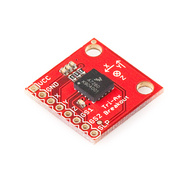 Triple Axis Accelerometer Breakout - MMA7260Q Description: This is a breakout board for Freescale's triple-axis MMA7260QT accelerometer. With a low power shut-down mode, high sensitivity output with selectable ranges (±1.5, 2, 4, and 6g), this was one of the very first sensors to market with three accelerometers built onto a single IC! Board comes fully assembled and tested with external filters installed. The MMA7260QT is a 3.3V part and outputs an analog voltage for each of the three outputs. This voltage is in ratio to the measured acceleration and to the supply voltage (ratiometric). You will need some extra hardware to convert this analog signal to a usable digital one. Luckily, many uCs have a built in Analog to Digital converter. |
| capacitance | electrical properties often associated with human touch | 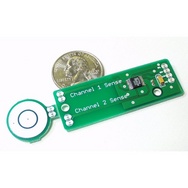 Description: Breakout board for the Analog Devices 7746 capacitance sensor. Configured for two channels of single-ended capacitance input. Comes with an example touch sensor as well as long capacitance creating traces. Useful as a complete I2C interfaced touch sensor, or as a capacitance measuring tool. |
| color | color | 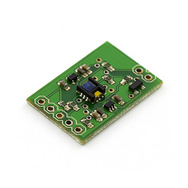 Color Light Sensor Evaluation Board Description: The ADJD-S371 is a great little sensor. This evaluation board provides all the necessary support circuitry to actually play with the sensor! |
| flex | angular position and changes | 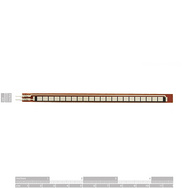 Flex Sensor 4.5" Description: A simple flex sensor 4.5" in length. As the sensor is flexed, the resistance across the sensor increases. Patented technology by Spectra Symbol - they claim these sensors were used in the original Nintendo Power Glove. The resistance of the flex sensor changes when the metal pads are on the outside of the bend (text on inside of bend). Connector is 0.1" spaced and bread board friendly. Check datasheet for full specifications. |
| force | physical pressure in an analog scale | 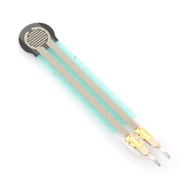 Force Sensitive Resistor - Small Description: This is a small force sensitive resistor. It has a 0.16" (4 mm) diameter active sensing area. This FSR will vary its resistance depending on how much pressure is being applied to the sensing area. The harder the force, the lower the resistance. When no pressure is being applied to the FSR, its resistance will be larger than 1MΩ, with full pressure applied the resistance will be 2.5kΩ. Two pins extend from the bottom of the sensor with 0.1" pitch making it bread board friendly. These sensors are simple to set up and great for sensing pressure, but they aren't incredibly accurate. Use them to sense if it's being squeezed, but you may not want to use it as a scale. |
| gas | alcohol, methane, CO2, CO, propane, etc | 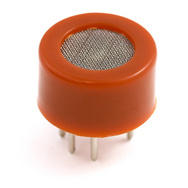 Alcohol Gas Sensor MQ-3 Description: This alcohol sensor is suitable for detecting alcohol concentration on your breath, just like your common breathalyzer. It has a high sensitivity and fast response time. Sensor provides an analog resistive output based on alcohol concentration. The drive circuit is very simple, all it needs is one resistor. A simple interface could be a 0-3.3V ADC. Features:
|
| gyroscope | rotation | 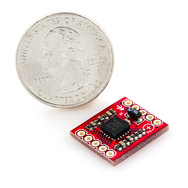 Gyro Breakout Board - LPY530AL Dual 300°/s Description: This is a breakout board for the ST's dual-axis LPY530AL gyro (don't mind the photos). The LPY530AL measures angular velocity along the pitch and yaw axes with a full scale of ±300°/s. Two different analog outputs are provided for both the x- and z- axes - one 1x amplified and the other 4x amplified. A regulated voltage between 2.7 and 3.6VDC should be supplied to the power pins. We have the filtering circuits all set up; you'll just need to connect the outputs to an ADC, and you're ready to go. This breakout board includes the gyro and all necessary filtering capacitors as shown. The 1x and 4x amplified outputs of both axes are connected to the 0.1" pitch headers, along with the power-down, self-test, high-pass filter reset, and power pins. |
| Hall effect | magnetic fields | 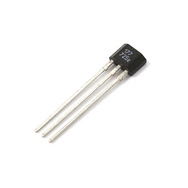 Description: The US1881 is an integrated Hall effect latched sensor. That's nice but what does it do? Holding a magnet near the sensor will cause the output pin to toggle. This makes for a robust presence sensor. A reed sensor also works nicely, but can be limited by the glass encapsulation and size. A hall effect sensor is much smaller, but can handle less current than a reed switch. The device includes an on-chip Hall voltage generator for magnetic sensing, a comparator that amplifies the Hall voltage, and a Schmitt trigger to provide switching hysteresis for noise rejection, and open-collector output. An internal bandgap regulator is used to provide temperature compensated supply voltage for internal circuits and allows a wide operating supply range. If a magnetic flux density larger than threshold Bop, DO is turned on (low). The output state is held until a magnetic flux density reversal falls below Brp causing DO to be turned off (high). Features:
|
| microphone/ acoustic | sound | 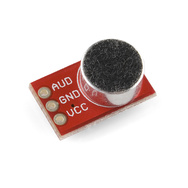 Breakout Board for Electret Microphone Description: Ready to add audio to your next project? This small breakout board couples a small electret microphone with a 100x opamp to amplify the sounds of voice, door knocks, etc loud enough to be picked up by a microcontroller's Analog to Digital converter. Unit comes fully assembled as shown. Works from 2.7V up to 5.5V. |
| motion | changes in relative distance | 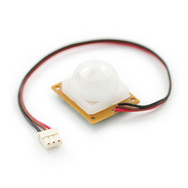 PIR Motion Sensor Description: This is a simple to use motion sensor. Power it up and wait 1-2 seconds for the sensor to get a snapshot of the still room. If anything moves after that period, the 'alarm' pin will go low. Red wire is power (5 to 12V). Brown wire is GND. Black wire is open collector Alarm. This unit works great from 5 to 12V (datasheet shows 12V). You can also install a jumper wire past the 5V regulator on board to make this unit work at 3.3V. Sensor uses 1.6mA@3.3V. The alarm pin is an open collector meaning you will need a pull up resistor on the alarm pin. The open drain setup allows multiple motion sensors to be connected on a single input pin. If any of the motion sensors go off, the input pin will be pulled low. The connector is slightly odd but has a 0.1" pitch female connector making it compatible with jumper wires and 0.1" male headers. |
| photocell | light |  Mini Photocell Description: This is a very small photocell. A photocell changes (also called a photodetector, CdS or photoconductive cell) resistance depending on the amount of light it is exposed to. These little sensors make great ambient light triggers (when light in the room turns on, do something). Features:
|
| pressure | air or fluid pressure | 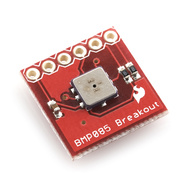 Barometric Pressure Sensor - BMP085 Breakout Description: This is a simple breakout board for the BMP085 high-precision, low-power barometric pressure sensor. The BMP085 offers a measuring range of 300 to 1100 hPa with an absolute accuracy of down to 0.03 hPa. It's based on piezo-resistive technology for EMC robustness, high accuracy and linearity as well as long term stability. This sensor supports a voltage supply between 1.8 and 3.6VDC. It is designed to be connected directly to a micro-controller via the I²C bus This breadboard-friendly board breaks out all pins of the BMP085 to a 6-pin 0.1" pitch header. The analog and digital supplies (VDDD and VDDA) of the BMP085 are tied together and broken out to a single pin. We've also put two 4.7k pull-up resistors on the I2C lines. Features:
|
| potentiometer | rotation or linear position on an analog scale | 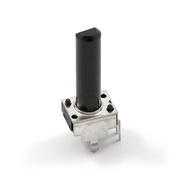 Rotary Potentiometer - Linear Description: An adjustable potentiometer can open up many interesting user interfaces. Turn the pot and the resistance changes. Connect VCC to an outer pin, GND to the other, and the center pin will have a voltage that varies from 0 to VCC depending on the rotation of the pot. Hook the center pin to an ADC on a microcontroller and get a variable input from the user! This is a center-tap linear type potentiometer. The outer two pins will always show 10K resistance, the center pin resistance to one of the outer pins will vary from 10K Ohm to about 50 Ohm. The pot is linear meaning the resistance will vary linearly with its position. This is a good choice for general user interfaces. This pot works great in a breadboard but on a few breadboards, you may have to trim off the large metal anchors. |
| pulse | heartbeat rate | 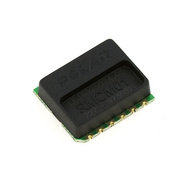 Polar Heart Rate Module - RMCM01 Description: This is a OEM module for the Polar Heart Rate system. This device works with any Polar heart rate strap to pickup the electromagnetic pulse and output a 1ms pulse indicating a heart beat has occurred. Embed a heart rate reading into your next project! The RMCM01 requires no antenna. It does require a 32kHz crystal but that crystal does not need capacitors. Please see the basic schematic below. |
| ranging | distance between objects | 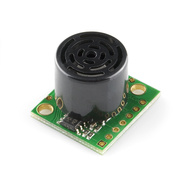 Ultrasonic Range Finder - Maxbotix LV-EZ1 Description: This is the fantastically easy to use sensor from Maxbotix. We are extremely pleased with the size, quality, and ease of use of this little range finder. The serial interface is a bit odd (it's RS232 instead of standard TTL), but the PWM and Analog interfaces will allow any micro to listen easily enough. The sensor provides very accurate readings of 0 to 255 inches (0 to 6.45m) in 1 inch increments with little or no dead zone! Maxbotix is offering the EZ0, EZ1, EZ2, EZ3, and EZ4 with progressively narrower beam angles allowing the sensor to match the application. Please see beam width explanation below. Control up to 10 sensors with only two pins! Checkout the Maxbotix FAQ listed below. Features:
|
| rotary encoder | rotation on a digital scale | 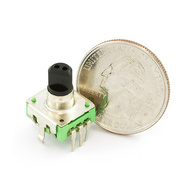 Description: This is a 12-step rotary encoder with a nice 'clicking' feel. It's breadboard friendly, and has a pretty handy select switch (by pushing in on the knob). The encoder is different from a potentiometer in that an encoder has full rotation without limits. The unit outputs gray code so that you can tell how much and in which direction the encoder has been turned. |
| stretch | physical deformation or strain |  Description:The Stretch Sensor is a unique component that changes resistance when stretched. When relaxed the sensor material has a nominal resistance of 1000 ohms per linear inch. As the stretch sensor is stretched the resistance gradually increases. When the sensor is stretched 50 % its resistance will approximately double to 2.0 Kohms per inch. |
| smoke | airborne particles | 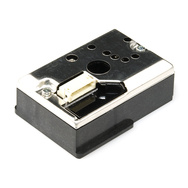 Optical Dust Sensor - GP2Y1010AU0F Description: Sharp's GP2Y1010AU0F is an optical air quality sensor, designed to sense dust particles. An infrared emitting diode and a phototransistor are diagonally arranged into this device, to allow it to detect the reflected light of dust in air. It is especially effective in detecting very fine particles like cigarette smoke, and is commonly used in air purifier systems. The sensor has a very low current consumption (20mA max, 11mA typical), and can be powered with up to 7VDC. The output of the sensor is an analog voltage proportional to the measured dust density, with a sensitivity of 0.5V/0.1mg/m3. To interface with the sensor you need to connect to its 6-pin, 1.5mm pitch connector; we do have a mating connector for this. |
| switch | physical pressure on a digital scale |  Concave Button - Red Description: This is a 35mm concave momentary push button similar to the ones you find on arcade games. Simple screw in design. Perfect for mashing. This button has a great tactile, 'clicky' feel. Features:
|
| thermistor | temperature |  Thermistor 10K Vishay part #: NTCLE100E3103JB0 Description: 10K thermistor with a negative temperature coefficient. Good choice for temp-sensing aplications. |
| tilt | angular attitude | 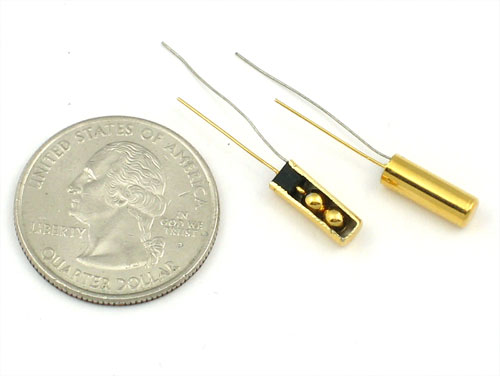 Description:The "poor man's" accelerometer! Tilt sensors are switches that can detect basic motion/orientation. The metal tube has a little metal ball that rolls around in it, when its tilted upright, the ball rolls onto the contacts sticking out of end and shorts them together. |
